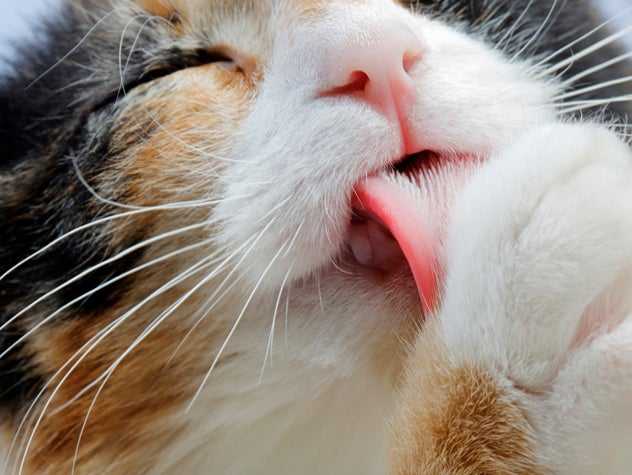Why Do Cats Lick Themselves?

When it comes to personal hygiene, cats are the epitome of cleanliness. They are naturally equipped with the implements to groom themselves: a barbed tongue with which to lick, forepaws they moisten with saliva and use as a surrogate washcloth, and teeth to dig out tougher debris. Believe it or not, adult cats may spend as much as half of their waking hours grooming themselves, their relatives and friends.
The Onset of Grooming
Mothers begin licking their kittens, right after birth, to clean them, stimulate them to release urine and feces, rouse them to suckle, and provide comfort. Kittens usually begin grooming themselves when they are about 4 weeks old. At 5 weeks of age, kittens also begin grooming their littermates, as well as their mom. Mutual grooming amongst littermates, called allogrooming, often continues into adulthood. Allogrooming is a social activity that serves to strengthen the bond between cats.
Licking Patterns
If you’ve ever watched a cat groom her face, you’ve probably noticed the highly stereotyped manner in which she does it: first saliva is applied to the inside of one paw, then, using an upward circular motion, the cat begins rubbing her nose with her paw from back to front. The cat will then reapply saliva to that paw and, using semi-circular motions, groom behind the corresponding ear, the back of the ear, the forehead and over the eye. When finished with one side, the process is repeated with the other paw on the other side of the head. After the head is clean, the cat grooms the front legs, shoulders, flanks, anogenital area, hind legs, and tail with long strokes of the tongue. The order of body parts may vary, and not all of these areas are necessarily groomed in one sitting.
Problematic Grooming
It comes as no surprise to anyone that grooming has hygienic benefits. It helps eliminate parasites, keep the cat’s coat clean and smooth, cool the cat down through evaporation of saliva, and stimulate glands attached to hair roots that secrete substances to keep hair water-proofed. However, grooming can also have psychological benefits. A cat may groom to temporarily reduce conflict, frustration, or anxiety. Under these conditions, licking becomes what is called a “displacement behavior.” Displacement behavior can occur when an animal is motivated to perform two or more conflicting behaviors simultaneously. Unable to do so, a third behavior arises that is out of context with the situation. For example, during a social conflict a cat that feels threatened may be conflicted between running from its attacker and fighting. Caught in a bind, the cat decides to groom instead! Grooming appears to calm and reassure the cat.
Over-grooming, in the form of excessive licking, biting, nibbling, chewing, or sucking the coat or skin, with no underlying medical cause, is typically indicative of stress. Common causes of feline stress are: fear, lack of stimulation, isolation, new pet in the household, move to a new household, separation anxiety, or in some cases early weaning. Over-grooming becomes problematic when it results in self-inflicted injury (hair thinning, removal of complete tufts of hair, skin infections), a condition called “Psychogenic Alopecia.” This diagnosis is made when no underlying medical condition can be detected. In some cases, excessive grooming can start in response to a skin irritation (fleas, allergies, infections), but it can escalate into a behavioral problem even though the condition has cleared. It is thought that the grooming behaviors become self-reinforcing by reducing anxiety. The grooming actions become repetitive, called “stereotypies,” that may come and go, depending on the cat’s current level of stress.
What Does It Mean if My Cat Grooms Me?
Cats are social animals. They lick their people as a display of affection and trust, the way they would lick littermates or their mother. They also may lick to taste any substance that is on your skin, such as salt.
Should You Groom Your Cat?
If your cat enjoys being brushed or combed then I encourage you to do so. Grooming your cat can serve to strengthen the bond between you and your pet. Grooming can also help you screen your cat for any problems that may be developing on the skin. However, many cats do not take fondly to being groomed by any tools but their own, so if you value your own safety, it’s best to leave these cats to take care of the job themselves! If your cat is prone to hairballs, matting fur, or excessive shedding, you may need to leave the grooming to a professional groomer.